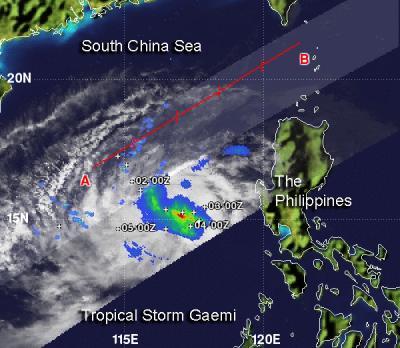Some of the most powerful thunderstorms in a tropical cyclone surround the center of circulation, and NASA's TRMM satellite noticed that rainfall is heaviest in that area of Tropical Storm Gaemi.
When NASA's Tropical Rainfall Measuring Mission (TRMM) satellite passed over Tropical Storm Gaemi on Oct. 3 at 1241 UTC (8:41 a.m. EDT), the precipitation radar instrument detected light rainfall occurring over most of the storm. Moderate rain was falling at a rate between .78 to 1.57 inches/20 to 40 mm per hour and surrounded a small area of heavy rainfall circling tightly around the around the center. The heaviest rain was falling at 2 inches (50 mm) per hour.
Satellite imagery on Oct. 4 shows that wind shear is taking a toll on the storm, pushing the bulk of the showers to the west, by strong easterly winds. The center of circulation also appears to be fully exposed to outside winds, which leaves the storm wide open for additional weakening influences.

When NASA's TRMM satellite passed over Tropical Storm Gaemi on Oct. 3 at 1241 UTC (8:41 a.m. EDT), light rainfall (blue) was occurring over most of the storm. Moderate rain (green and orange) was falling at a rate between .78 to 1.57 inches/20 to 40 mm per hour and surrounded a small area of heavy rainfall (red) circling tightly around the center. The heaviest rain was falling at 2 inches (50 mm) per hour.
(Photo Credit: SSAI/NASA, Hal Pierce)
On Tuesday, Oct. 3, 2012 at 1500 UTC (11 a.m. EDT), Tropical storm Gaemi had maximum sustained winds near 35 knots (40 mph/65 kph). It was located 605 nautical miles (696 miles/1,120 km) east of Hue, Vietnam near 14.7 North latitude and 117.7 East longitude. Gaemi was moving to the west at 2 knots (2.3 mph/3.7 kph).
Gaemi is expected to start moving around an area of high pressure nearby strengthens, which would push the storm west toward Vietnam. Gaemi is forecast to make landfall south of Hue, Vietnam sometime on Oct. 6. As the storm nears coastal conditions will deteriorate.
Source: NASA/Goddard Space Flight Center